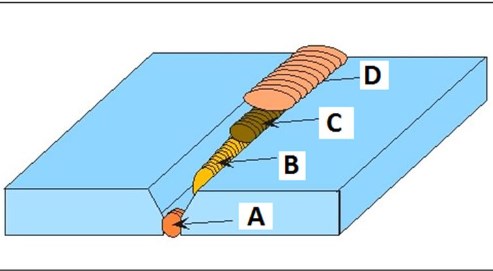Multipass welding is a critical technique in modern welding, enabling the creation of strong, durable joints by depositing multiple layers of weld metal. This method is particularly valuable for thick materials, complex geometries, and applications requiring superior mechanical properties. Whether you're working on heavy machinery, construction, or aerospace components, multipass welding offers unparalleled benefits. This guide explores the ins and outs of multipass welding, providing insights into its advantages, challenges, and step-by-step execution.
I. What is Multipass Welding?
Multipass welding involves creating multiple weld passes along a joint to achieve the desired thickness, strength, and quality. Each pass adds a layer of weld metal, allowing for precise control over the weld’s microstructure and properties. This technique is adaptable across various welding processes, including:
GMAW (Gas Metal Arc Welding): Ideal for high-speed, high-deposition welding on steel and aluminum.
FCAW (Flux-Cored Arc Welding): Offers deep penetration and works well with thick materials.
SMAW (Shielded Metal Arc Welding): Provides flexibility and portability for on-site repairs.
GTAW (Gas Tungsten Arc Welding): Produces high-purity welds, perfect for stainless steel and titanium.

II. Why is Multipass Welding Important?
Multipass welding has several advantages over single-pass welding, especially for thick or complex joints. Some of the benefits of multipass welding are:
Enhanced Strength and Durability: By building up multiple layers, multipass welding minimizes residual stresses and improves the joint’s overall integrity.
Improved Microstructure: Each pass refines the microstructure, reducing grain size and enhancing mechanical properties.
Defect Reduction: Multiple passes allow for the correction of imperfections, reducing the risk of porosity, lack of fusion, and slag inclusions.
Design Flexibility: Enables the creation of complex shapes and contours through layer-by-layer welding.
III. Challenges in Multipass Welding
While multipass welding offers significant benefits, it also presents challenges that require careful management:
Distortion: Thermal expansion and contraction can lead to warping, especially in thin or large components.
Cracking: High residual stresses or incorrect interpass temperatures can cause weld metal cracking.
Porosity and Slag Inclusions: Improper shielding or insufficient cleaning between passes can introduce defects.
Increased Time and Cost: Multipass welding requires more time and resources compared to single-pass welding.
IV. Best Practices for Multipass Welding
To master multipass welding, follow these step-by-step guidelines:
1. Joint Preparation
Cleanliness: Ensure the joint is free from contaminants like oil, grease, rust, or paint.
Fit-Up: Achieve precise alignment and fit-up to avoid gaps that could lead to lack of fusion.
Surface Finish: Grind or mill surfaces for optimal contact and weld penetration.
2. Selecting the Right Process and Parameters
Welding Process: Choose based on material type, thickness, and required weld properties.
Parameters: Optimize voltage, current, and travel speed for each pass to maintain consistent penetration and bead profile.
3. Filler Metal Selection
Base Metal Matching: Ensure filler metals meet or exceed the base metal's mechanical properties.
Compatibility: Consider weldability, ductility, and resistance to corrosion or heat.
Certifications: Use filler metals that comply with relevant industry standards (e.g., AWS, EN).
4. Heat Input Control
Monitoring: Use thermocouples or thermal imaging cameras to track interpass temperatures.
Limits: Typically, maintain interpass temperatures between 100°C to 250°C, depending on the material.
5. Pass Sequence and Technique
Root Pass: Focus on full penetration of the joint to ensure integrity.
Fill Passes: Build up the weld gradually, ensuring each layer fuses with the previous one.
Cap Pass: Finish with a smooth, even surface, using a weaving technique if necessary.
Cleaning: After each pass, remove slag and spatter using wire brushes, grinders, or solvents.
V. Applications of Multipass Welding
Multipass welding is indispensable in industries requiring robust and durable welds:
Shipbuilding: For thick-hulled vessels and structural components.
Aerospace: Welding high-strength, lightweight materials like titanium and aluminum alloys.
Power Generation: Repairing and fabricating components in power plants.
Construction: Welding heavy-duty steel beams and structural frameworks.
Oil and Gas: Pipeline welding requiring high strength and resistance to environmental factors.
VI. Optimizing Multipass Welding with Advanced Technology
Leverage modern innovations to enhance your multipass welding processes:
Automated Welding Systems: Increase consistency and reduce labor costs with robotic welding solutions.
Real-Time Monitoring: Use systems like Megmeet’s SMARC Welding Cloud for data tracking and quality control.
Advanced Filler Metals: Utilize high-performance filler metals designed for specific applications.
VII. FAQs: Multipass Welding
1. What materials are suitable for multipass welding?
Most metals, including steel, stainless steel, aluminum, and titanium, can be multipass welded with the right parameters.
2. How many passes are typically required?
It varies by application, but thick materials may require 5-10 passes or more.
3. What causes cracking in multipass welds?
High residual stress, improper interpass temperatures, or lack of preheating can lead to cracking.
4. Can multipass welding be automated?
Yes, with the use of advanced robotic systems, improving efficiency and reducing human error.
5. What is the recommended interpass temperature for steel?
What is the recommended interpass temperature for steel?
Conclusion: Mastering Multipass Welding
Multipass welding is a powerful technique for achieving high-quality, durable joints in demanding applications. By adhering to best practices and leveraging advanced technology, welders can overcome challenges and unlock the full potential of multipass welding.
For professionals seeking reliable equipment and innovative solutions, Megmeet Welding Technology offers a range of high-performance welding machines designed for multipass welding. Explore Megmeet’s products at https://www.megmeet-welding.com/en/products and take your welding operations to the next level.
If you want to learn more about multipass welding or other welding topics, you can visit Megmeet Welding, a leading manufacturer and supplier of welding equipment and solutions. You can also check out their blog post on What are the 4 Basic Welding Positions and How to Choose, which will help you understand how to weld in different orientations.
Related articles:
1. What are the 4 Basic Welding Positions and How to Choose the Right One?
2. How to Choose the Best Welding Equipment for Automotive Applications?
3. Choosing the Right Welding Technique: Suggestions for Different Applications
4. Choosing the Right Welding Process: MIG vs TIG vs Stick vs Flux Core Welding
5. MIG/MAG, MMA, TIG Welding: Choosing the Right Technique




